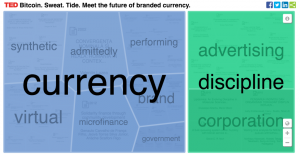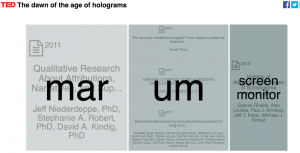Become a teacher of our young AI scientist!
Become a teacher of Iris.AI, our young research assistant!
Imagine attending a lecture on a topic you know nothing about in advance. Although your brain is working hard to make sense of what the teacher is saying, you are only able to grasp some small fractions of the content.
In February we put our AI science assistant Iris.AI on “a lecture” like that. The only difference was that, instead of one topic, we gave Iris.AI the full body of TED talks to make sense of. This body consists of more than 2,000 talks covering all the fields you could possibly imagine. Iris.AI was not just assigned to read through all the texts but, more importantly, to capture the meaning of each text as well.
We structured the first version of Iris.AI’s brain using NLP algorithms. That structure enabled her to extract key concepts from the talks through a process that consists of analysing ways in which words are used in the text, understanding what those words mean in their context, finding synonyms, filtering out irrelevant content, building “mind maps” that we call concept trees across all the talks, and finally, setting those concepts in a hierarchical structure.
How well did she perform? Well, sometimes she was killing it:

… and sometimes she got totally lost:

We measure Iris.AI’s ability to understand what she reads based on the number of relevant concepts that she extracts from the texts we give her to read. Currently, we estimate that she manages to get the concepts right with 70 % probability.
It’s a fairly good start, but our goal is, of course, to get close to 100 %. Now, the question is how to get there. How can we train this artificial brain to understand the meaning of textual content like an expert?
Let’s get back to that lecture. You thought it was interesting and you would like to learn more. To expand your understanding you probably end up reading more about the topic and asking your peers what they think about it.
This is exactly how the curriculum of Iris.AI looks like in the near future. Her algorithmic brain will learn in the upcoming months by being exposed to more data and, even more importantly, by asking her peers, that is human beings, what they think about the texts that she has just familiarised herself with.
Thoughts of peers are important because texts are, by definition, summaries of thoughts written by human beings. We want Iris.AI to be able to understand those thoughts and the best way to go about it is to ask people to articulate them. As simple as that, almost…
Thoughts are highly personal, too. You go and ask people to summarize the same text and you probably get as many answers as there are respondents. To minimize the risk of bias in interpretation, you better ask the opinion from far more than one or two peers.
We’re launching an AI crowd training platform next week. Through that platform, we’ll initially ask thousands of volunteering AI trainers from various backgrounds what they think is most relevant in the TED talks they’ve watched. In this process the trainers will be able help Iris.AI grasp the meaning of the talks via three different types of mechanisms:
Firstly, the AI trainers are asked to validate the concepts that Iris.AI has already extracted from the TED talks by choosing the ones that they think are relevant. Secondly, AI trainers will be able to make corrections to the concepts and thirdly they can give Iris.AI new food for thought, i.e. new knowledge in the form of new concepts.
With thousands of inputs from our AI trainers we’ll be able optimize the artificial brain of Iris.AI. Through this process certain concepts start to get more emphasis while new concepts are emerging. The algorithm won’t change immediately after trainers’ inputs, though, as it takes some time to gather enough data. Eventually, with that data, our AI scientist’s brain starts to mimic the thinking of her teachers.
AI training is very much like teaching, but we hope that it’s not just the brain of Iris.AI that grasps new ideas and develops. Optimally training becomes a two-directional process where the trainers’ thinking evolves as well.
We’re now looking for teachers willing to participate in this huge learning experiment. You don’t need to be a researcher or an AI expert to participate. On the contrary, the more we have teachers from different backgrounds, the merrier. The training tool we’ve been building in the past couple of months is almost ready. If you’d like to be among the first ones to try it out, sign up for our AI fellowship program and you’ll become a teacher of a young, but ambitious, AI scientist.